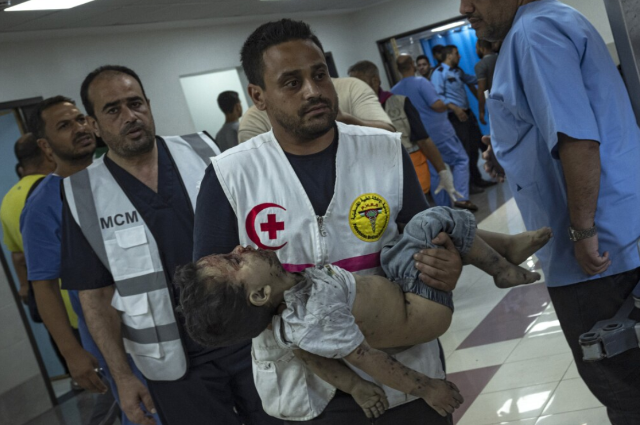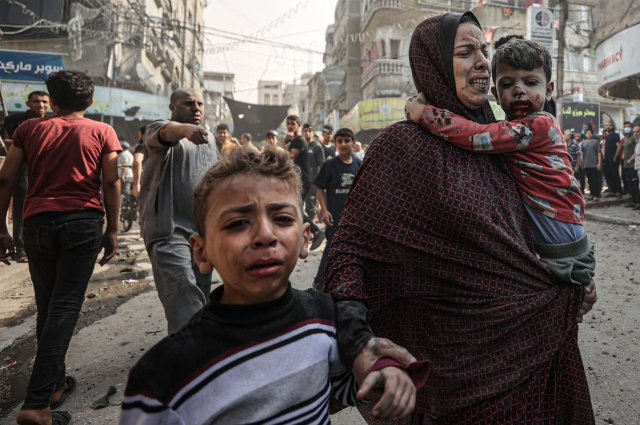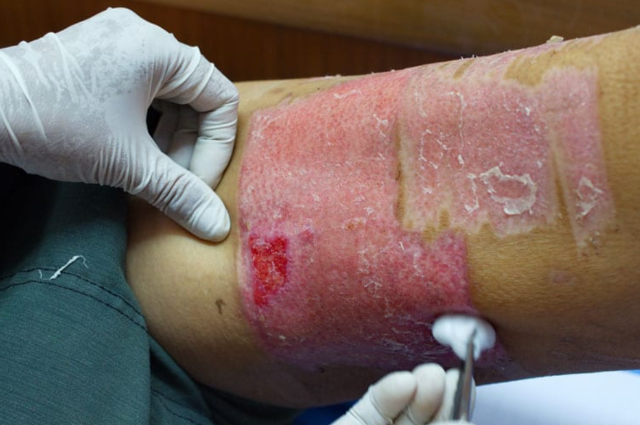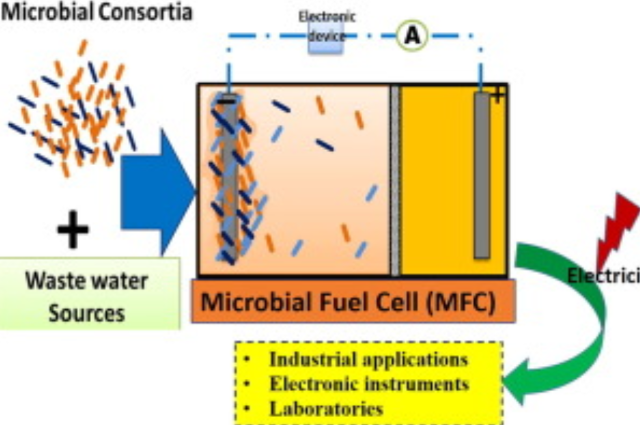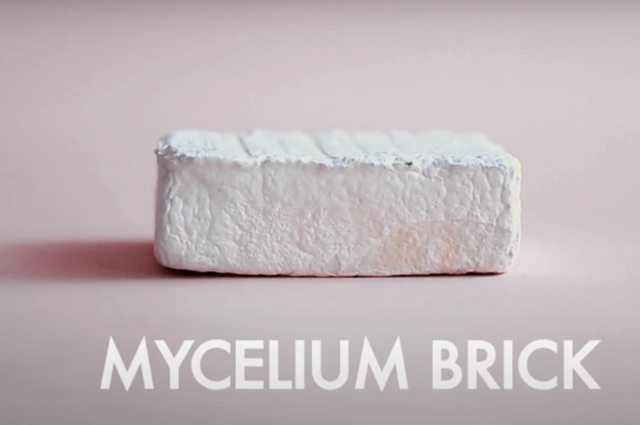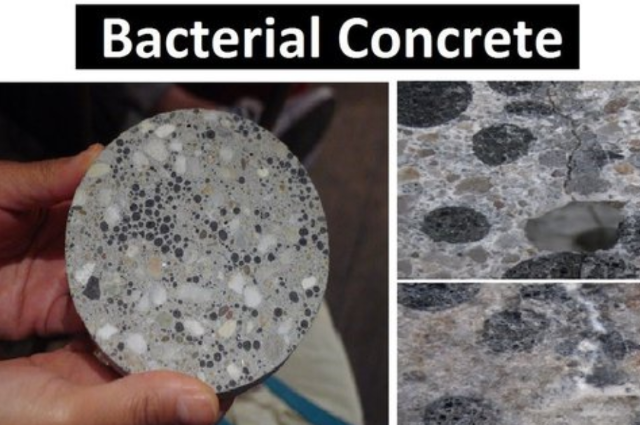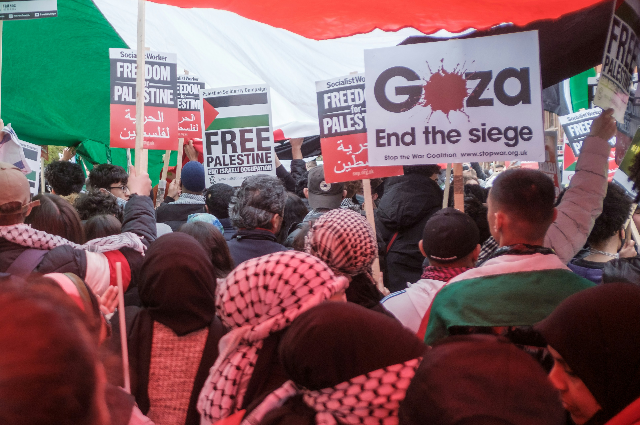
Imagine, for a moment, that you are in the heart of a warzone. The air is filled with the deafening sounds of explosions. Screams of terror and despair pierce through the chaos. Military personnel fire indiscriminately, and the people you love are caught in the crossfire. Homes are reduced to rubble. Blood flows in the streets as people lie on the ground, dying. This is not a scene from a distant nightmare; it is the brutal reality for the children, women, and men of Gaza. Children who dream of going to school end up in graves, while children elsewhere refuse to leave their beds in the morning. Women, desperate to provide for their families, are left mourning their dead or clinging to life in the ruins of their homes. Men and women struggle to find even the most basic necessities. No water. No food. Nothing.
“As the hostilities between Israel and Hamas continue, we mourn the tens of thousands of lives lost and continue to implore all organizations and combatants with the capacity, the influence, and the remit to please do whatever possible to both protect and deliver immediate relief for the innocent civilians, aid workers and emergency responders suffering from this devastation, particularly our Movement partners in the region. The fact that innocent civilians continue to be held hostage is unacceptable and their safe release must remain a top priority..." - A statement that may be attributed to the American Red Cross.
Amid this unimaginable suffering, bioengineering offers a glimmer of hope. By harnessing cutting-edge science, we can bring transformative solutions to Gaza. From healthcare innovations and clean water technologies to sustainable food production and renewable energy sources, bioengineering can provide the tools to rebuild and thrive in the face of adversity. This article explores how bioengineering is not just a field of study but a beacon of hope for a resilient Gaza.
Healthcare in Crisis
A Broken System: How War Has Shattered Gaza’s Healthcare Infrastructure
In the heart of Gaza, a healthcare system once full of potential lies in ruins, shattered by years of relentless conflict and blockade. Hospitals that should be sanctuaries of healing are instead scenes of despair, overwhelmed by the ceaseless influx of casualties and the scarcity of essential supplies. The cries of the injured echo through hallways that have become all too familiar with the scent of blood and the sight of suffering.
Overwhelmed Hospitals
Hospitals in Gaza are operating far beyond their capacity. Emergency rooms, once equipped to handle a manageable number of patients, now face an unending stream of injured civilians. Medical staff are stretched to their limits, working around the clock with dwindling resources. Basic medical supplies, from bandages to antibiotics, are in critically short supply, and advanced medical equipment is often damaged or outdated. The ongoing blockade severely restricts the import of new medical technologies and pharmaceuticals, exacerbating the crisis.
Power and Water Shortages
The healthcare infrastructure in Gaza is further crippled by chronic power and water shortages. Frequent power outages disrupt the functioning of critical medical equipment, putting patients’ lives at risk. Generators, the lifeline of hospitals, often run out of fuel, plunging operating rooms into darkness. Clean water, essential for maintaining hygiene and preventing infections, is a luxury that many hospitals cannot afford. Contaminated water supplies contribute to the spread of waterborne diseases, compounding the healthcare crisis.
Access to Treatment
Access to treatment is another significant challenge. The movement of patients needing specialized care outside Gaza is severely restricted. Many cannot receive the advanced treatments they require, leading to preventable deaths and prolonged suffering. This isolation not only affects patients but also healthcare professionals who are unable to receive training or collaborate with international colleagues, stifling medical advancements and knowledge exchange.
Mental Health Crisis
The psychological toll on Gaza’s residents cannot be understated. The constant threat of violence, loss of loved ones, and destruction of homes have led to widespread trauma and mental health disorders. Yet, mental health services are scarce, and stigma often prevents individuals from seeking the help they need. The few available services are overwhelmed, and there is an urgent need for more mental health professionals and resources.
Bioengineering Solutions: A Ray of Hope
Despite the devastation, bioengineering offers a glimmer of hope for rebuilding Gaza’s healthcare infrastructure. Portable diagnostic tools can provide quick and accurate medical assessments in the field, easing the burden on hospitals. Regenerative medicine and tissue engineering hold promise for treating injuries that are currently beyond the capabilities of Gaza’s medical facilities. Moreover, telemedicine platforms can bridge the gap, allowing local healthcare providers to consult with international specialists and access training remotely.
Bioengineering also has the potential to address the critical shortages of medical supplies. Advances in biomanufacturing can enable the local production of essential medicines and medical materials, reducing dependency on imports. Additionally, bioengineered solutions for clean water and sustainable energy can alleviate the infrastructural challenges that plague Gaza’s healthcare system.
Healing Amidst Chaos: Portable Diagnostic Tools as Lifesavers
In the war-torn landscape of Gaza, where chaos reigns and medical infrastructure is in shambles, the ability to quickly diagnose and treat injuries and diseases can mean the difference between life and death. With hospitals overwhelmed and supplies dwindling, innovative solutions are urgently needed. Enter portable diagnostic tools—compact, versatile, and lifesaving technologies that are revolutionizing healthcare delivery in the most challenging environments.
The Reality on the Ground
Imagine a medical clinic in Gaza: patients flooding in, many with severe injuries from explosions or gunfire, others suffering from chronic illnesses exacerbated by the lack of consistent medical care. Doctors and nurses, already working under extreme pressure, must make rapid decisions with limited information. In such a scenario, traditional diagnostic methods—often requiring large, immobile equipment and extensive laboratory resources—are impractical.
Portable Diagnostic Tools: A Game Changer
Portable diagnostic tools are transforming this grim reality. These devices, which can fit into a backpack, provide immediate, reliable diagnostics at the point of care. Here’s how they are making a crucial impact:
1. Point-of-Care Ultrasound (POCUS)
Point-of-care ultrasound devices are compact and can be used anywhere, from makeshift clinics to the sites of bombings. They allow healthcare providers to quickly assess internal injuries, guide emergency procedures, and monitor patient conditions without needing to transport patients to a hospital. This immediate access to diagnostic imaging can significantly reduce mortality rates in trauma cases.
2. Handheld Blood Analyzers
Handheld blood analyzers can perform a range of tests, from blood glucose levels to electrolyte balances, within minutes. This rapid testing capability is vital for managing both acute and chronic conditions, such as diabetes and kidney disease, which are prevalent in Gaza. By providing quick results, these devices enable timely interventions that can prevent complications and save lives.
3. Portable PCR Machines
Portable PCR (Polymerase Chain Reaction) machines are essential for detecting infectious diseases, including COVID-19, tuberculosis, and various viral infections. In an environment where outbreaks can quickly become unmanageable, the ability to diagnose infections on-site ensures that patients receive appropriate treatment promptly and helps contain the spread of diseases.
4. Mobile ECG Devices
Mobile ECG (Electrocardiogram) devices can monitor heart conditions in real time. For patients with cardiovascular diseases—whose conditions may be exacerbated by stress and lack of medical resources—these devices offer a lifeline. They provide critical data that can guide immediate and long-term treatment plans, even in settings with no access to advanced cardiac care.
5. Telemedicine Kits
Telemedicine kits equipped with diagnostic tools and connectivity features allow healthcare providers in Gaza to consult with specialists worldwide. This collaboration can lead to better diagnostic accuracy and treatment plans, leveraging global medical expertise to support local efforts.
Impact on Healthcare Delivery
The introduction of portable diagnostic tools in Gaza is more than a technological advancement; it’s a humanitarian necessity. These tools:
Enhance Diagnostic Accuracy: With precise, on-the-spot diagnostics, healthcare providers can make informed decisions swiftly, improving patient outcomes.
Reduce Hospital Burden: By diagnosing and treating patients on-site, these tools alleviate the pressure on overburdened hospitals, freeing up resources for the most critical cases.
Improve Access to Care: Portable devices can be deployed in remote areas and temporary shelters, ensuring that even the most vulnerable populations receive essential medical attention.
Support Public Health Initiatives: Quick and accurate diagnostics are crucial for managing public health crises, from infectious disease outbreaks to monitoring chronic disease prevalence.
Challenges and the Path Forward
Despite their potential, the deployment of portable diagnostic tools in Gaza faces challenges. Supply chains are disrupted by the blockade, and there is a need for training local healthcare providers to use these advanced tools effectively. International collaboration and support are vital to overcoming these hurdles. Partnerships with NGOs, international health organizations, and bioengineering firms can ensure that these lifesaving technologies reach those who need them most.
Conclusion: A Beacon of Hope
Amid Gaza’s turmoil, portable diagnostic tools offer a beacon of hope. They represent a blend of innovation and compassion, bringing critical healthcare services to the frontlines of conflict. By continuing to develop and deploy these technologies, we can help heal amidst the chaos, saving lives and restoring dignity to those who have endured so much.
Regenerating Hope: Tissue Engineering for War-Torn Bodies
In Gaza, where conflict has wrought untold devastation, the physical scars of war are evident everywhere. Explosions, gunfire, and collapsing buildings leave behind not just the dead but countless individuals with severe injuries. For these survivors, the path to recovery is long and fraught with challenges. Traditional medical interventions often fall short in such extreme conditions, but tissue engineering offers a groundbreaking solution—regenerating hope and restoring lives amidst the ruins.
The Dire Need for Advanced Medical Solutions
In the aftermath of violence, medical facilities in Gaza are inundated with patients suffering from traumatic injuries: severe burns, amputations, deep lacerations, and complex fractures. The local healthcare system, already under severe strain, struggles to provide adequate care. Chronic shortages of medical supplies and specialists further complicate treatment, leading to prolonged suffering and, in many cases, permanent disability.
Tissue Engineering: A Ray of Hope
Tissue engineering represents a beacon of hope for those with severe injuries. By using a combination of cells, engineering, and materials, this innovative field aims to restore, maintain, or enhance tissue function. Here’s how it is transforming medical care in conflict zones like Gaza:
1. Skin Regeneration for Burn Victims
Burn injuries are among the most painful and difficult to treat. Traditional skin grafts are limited by donor site availability and often lead to scarring. Tissue-engineered skin substitutes, made from biocompatible scaffolds and the patient’s own cells, can significantly improve healing outcomes. These substitutes provide a temporary barrier while promoting the regeneration of the patient’s skin, reducing scarring and infection risks.
2. Bone and Cartilage Repair
Explosions and gunfire frequently result in complex bone fractures and cartilage damage. Tissue engineering enables the creation of bioactive scaffolds that support bone and cartilage regeneration. These scaffolds can be implanted at the injury site, where they gradually integrate with the patient’s natural tissue, facilitating effective healing and restoring mobility.
3. Vascular Grafts for Severe Injuries
Severe trauma often damages blood vessels, leading to life-threatening conditions. Engineered vascular grafts can replace damaged segments of blood vessels, restoring circulation and preventing limb loss. These grafts are designed to be biocompatible and can integrate seamlessly with the patient’s existing vasculature.
4. Limb Reconstruction
For those who have lost limbs, traditional prosthetics offer limited functionality and comfort. Advances in tissue engineering are paving the way for more sophisticated solutions, such as biohybrid limbs that combine synthetic materials with the patient’s tissues. These innovations promise better mobility, comfort, and a more natural appearance.
5. Regenerative Medicine for Soft Tissue Injuries
Soft tissue injuries, including muscle and tendon damage, are common in war zones. Tissue engineering techniques can regenerate these tissues using scaffolds seeded with the patient’s cells. These scaffolds support the growth and integration of new tissue, leading to more effective and quicker recovery compared to conventional treatments.
Challenges and Overcoming Them
While the potential of tissue engineering is immense, its implementation in Gaza faces several hurdles:
- Resource Limitations: The blockade and ongoing conflict make it challenging to obtain the necessary materials and equipment. Establishing reliable supply chains is critical.
- Training and Expertise: Specialized knowledge is required to perform tissue engineering procedures. International collaboration and training programs can help build local expertise.
- Infrastructure: Adequate laboratory and clinical facilities are essential for tissue engineering. Investment in healthcare infrastructure is necessary to support these advanced treatments.
Collaborative Efforts and Future Directions
International partnerships are vital to bringing tissue engineering to Gaza. Non-governmental organizations (NGOs), academic institutions, and bioengineering companies can collaborate to provide resources, training, and technological support. Mobile clinics equipped with tissue engineering capabilities could serve as interim solutions, delivering advanced care directly to those in need.
Impact on Lives and Communities
The benefits of tissue engineering extend beyond individual patients. By restoring functionality and reducing long-term disabilities, these technologies enable individuals to regain their independence and contribute to their communities. This not only improves the quality of life for the injured but also strengthens the social fabric of Gaza, fostering resilience and hope.
Conclusion: A Path to Healing
In a region where hope often seems scarce, tissue engineering offers a transformative path to healing. By leveraging cutting-edge science, we can provide war-torn bodies with the means to recover and thrive. This innovative approach not only addresses immediate medical needs but also builds a foundation for a healthier, more resilient future for Gaza. Through continued research, collaboration, and investment, we can ensure that the promise of tissue engineering reaches those who need it most, regenerating hope amidst the chaos.
Water Scarcity and Sanitation
Thirst in the Rubble: The Dire Water Crisis in Gaza
In Gaza, the struggle for clean, safe water is a daily battle. Years of conflict have ravaged the region’s infrastructure, leaving the water supply system in a state of disrepair. Bombings and blockades have destroyed pipelines and treatment facilities, leading to widespread contamination. Residents face severe water shortages, with many relying on unsafe sources that expose them to life-threatening diseases. The scarcity of potable water exacerbates health issues and hampers efforts to maintain hygiene, further endangering an already vulnerable population.
Turning the Tide: Bioremediation Technologies for Clean Water
Bioremediation offers a beacon of hope in Gaza’s dire water situation. This innovative approach uses natural and engineered microorganisms to detoxify polluted water sources, making them safe for consumption. Here’s how bioremediation technologies are transforming water sanitation in Gaza:
1. Microbial Clean-Up Crews
Specific strains of bacteria can break down harmful contaminants such as heavy metals, pesticides, and industrial chemicals found in Gaza’s water supply. By introducing these bacteria into polluted water sources, bioremediation can significantly reduce the levels of toxins, rendering the water safe for use.
2. Phytoremediation
This method utilizes plants to absorb and neutralize pollutants from the water. Certain plant species have a remarkable ability to take up heavy metals and other contaminants through their roots, effectively cleaning the water as it passes through their root systems. These plants can be cultivated around water sources and drainage areas, creating a natural filtration system.
3. Constructed Wetlands
Engineered wetlands mimic the natural processes of wetland ecosystems to purify water. These systems use a combination of soil, plants, and microorganisms to filter out contaminants. Constructed wetlands can be implemented near urban areas and refugee camps, providing a sustainable and low-maintenance solution for water purification.
4. Biofiltration Systems
Biofiltration involves passing contaminated water through a filter composed of bioactive materials, such as sand and gravel inoculated with beneficial bacteria. These systems can be set up at community water points, providing immediate and accessible clean water to residents.
Desalination Dream: Bioengineering Solutions to Quench Gaza’s Thirst
Desalination, the process of removing salt from seawater to produce fresh water, is a promising solution for Gaza’s water crisis. Bioengineering advancements are making desalination more affordable and efficient, turning the dream of plentiful clean water into a reality.
1. Algae-Based Desalination
Bioengineered algae can be used in innovative desalination processes. Certain algae species are capable of absorbing salt from seawater. Researchers are developing systems where algae are cultivated in controlled environments to desalinate water efficiently. The algae not only remove salt but also produce biomass that can be used for biofuels or other purposes.
2. Microbial Desalination Cells
These cells use electroactive bacteria to drive desalination processes. By harnessing the metabolic activities of these bacteria, microbial desalination cells generate an electric current that helps separate salt from water. This method is energy-efficient and can be integrated into small-scale, decentralized water treatment systems.
3. Forward Osmosis
Forward osmosis is an emerging technology that uses a semi-permeable membrane to draw water through, leaving salts and other impurities behind. Bioengineered membranes, enhanced with specific proteins or nanoparticles, can significantly improve the efficiency and cost-effectiveness of forward osmosis desalination.
4. Solar-Powered Desalination Units
Solar energy is abundant in Gaza, making solar-powered desalination an attractive option. Bioengineered materials can enhance the efficiency of solar desalination units, reducing the energy requirements and increasing the output of fresh water. These units can be deployed in remote areas, providing off-grid solutions to water scarcity.
Conclusion: A Sustainable Future for Gaza’s Water
The water crisis in Gaza is a profound humanitarian challenge, but bioengineering offers innovative and practical solutions. Through bioremediation, advanced desalination technologies, and sustainable practices, we can turn the tide on water scarcity and ensure that the people of Gaza have access to the clean water they desperately need. By continuing to invest in and deploy these technologies, we can build a more resilient and healthy future for Gaza, where the basic human right to safe water is fulfilled for all.
Food Security in Peril
Hunger and Desperation: Food Scarcity in a Blockaded Land
In Gaza, food security is a pressing issue exacerbated by the ongoing conflict and blockade. The restrictions on imports and exports have crippled the local economy, limiting access to essential food supplies. Agricultural land has been destroyed, water resources are scarce, and the fishing industry is severely restricted. As a result, many families struggle to obtain enough nutritious food, leading to widespread hunger and malnutrition. Children are particularly vulnerable, with many suffering from stunted growth and developmental issues due to inadequate diets.
Seeds of Change: Genetically Modified Crops for a Barren Land
Genetically Modified (GM) crops offer a promising solution to the food scarcity in Gaza. By developing crops that are more resilient to harsh conditions and have higher nutritional value, bioengineering can help ensure a stable food supply even in a blockaded land.
1. Drought-Resistant Crops
Water scarcity is a major challenge in Gaza. GM crops that are engineered to be drought-resistant can thrive with minimal water, ensuring consistent yields even during dry periods. These crops can help maintain food production despite the limited availability of water.
2. Pest-Resistant Varieties
Pests are a significant threat to crops, especially in an environment where chemical pesticides are hard to come by. GM crops can be engineered to be resistant to local pests, reducing the need for pesticides and increasing crop yields. This resistance can help safeguard the food supply and support sustainable farming practices.
3. Nutritionally Enhanced Foods
Bioengineering can enhance the nutritional content of staple crops. For example, rice and maize can be fortified with essential vitamins and minerals, such as Vitamin A, iron, and zinc. These nutritionally enhanced crops can help address malnutrition and improve overall health outcomes for the population.
4. Salt-Tolerant Plants
Given the high salinity of some of Gaza’s water sources, developing salt-tolerant crops is crucial. GM crops that can grow in saline conditions would make better use of the available water resources, increasing food production and making agriculture more sustainable in Gaza’s challenging environment.
Aquaponics Revolution: Sustainable Food Production in Urban Ruins
Aquaponics, the combination of aquaculture (raising fish) and hydroponics (growing plants without soil), presents an innovative and sustainable solution for food production in Gaza’s urban and severely damaged areas. This method not only maximizes the use of limited space but also recycles water, making it ideal for a region with water scarcity and limited arable land.
1. Efficient Use of Space
Aquaponics systems can be set up in small urban spaces, including rooftops, backyards, and even abandoned buildings. This flexibility allows for food production close to where people live, reducing transportation costs and ensuring fresher produce.
2. Water Conservation
Aquaponics uses significantly less water than traditional agriculture because the water in the system is recirculated. Fish waste provides essential nutrients for the plants, and the plants, in turn, help to filter and clean the water, which is then returned to the fish tanks. This closed-loop system conserves water and reduces the need for chemical fertilizers.
3. Year-Round Production
Aquaponics systems can be operated indoors or in greenhouses, allowing for year-round food production. This continuous cycle of growth can help mitigate the impact of seasonal variations and ensure a steady supply of fresh vegetables and fish throughout the year.
4. Community Empowerment
Aquaponics can empower communities by providing them with the means to produce their food. Local aquaponics projects can create jobs, provide educational opportunities, and strengthen community resilience. These projects can be particularly beneficial for women and youth, offering new skills and economic opportunities.
Conclusion: A Path to Food Security
The food security crisis in Gaza requires innovative and sustainable solutions. Through the use of genetically modified crops and aquaponics, it is possible to enhance food production and ensure a reliable supply of nutritious food. By investing in these bioengineered solutions, Gaza can move towards a future where hunger and malnutrition are no longer daily threats. These technologies not only address immediate food needs but also build the foundation for a resilient and self-sufficient agricultural system, capable of withstanding the challenges posed by conflict and environmental stress.
Energy Solutions Amid Destruction
Powerless Nights: The Struggle for Reliable Energy in Gaza
In Gaza, energy shortages are a chronic issue, exacerbated by the ongoing conflict and blockade. The destruction of power plants, fuel shortages, and damaged infrastructure result in frequent and prolonged power outages. For many residents, this means powerless nights, where basic activities such as cooking, studying, and maintaining household hygiene become monumental challenges. Hospitals and essential services often rely on unstable and expensive generators, which are not always reliable due to fuel scarcity. The lack of reliable energy not only affects daily life but also hampers economic activities, education, and healthcare, deepening the humanitarian crisis.
Lighting the Dark: Microbial Fuel Cells as a Beacon of Hope
Microbial fuel cells (MFCs) offer a promising solution to Gaza’s energy crisis. These innovative devices generate electricity through the metabolic processes of bacteria, converting organic matter into power. Here’s how MFCs can make a difference in Gaza:
1. Sustainable Energy Production
MFCs use waste materials such as sewage, agricultural residues, and organic waste to produce electricity. In Gaza, where waste management is a significant issue, this dual-function technology can help address waste disposal problems while generating much-needed energy.
2. Low-Cost and Low-Maintenance
MFCs are relatively inexpensive to construct and maintain, making them accessible for communities with limited resources. They can be implemented on a small scale, providing local energy solutions that do not rely on the fragile central grid.
3. Scalability and Flexibility
These cells can be scaled up or down to meet varying energy needs, from powering small household devices to larger community installations. This flexibility makes them suitable for diverse applications, including powering remote clinics, schools, and homes.
4. Environmental Benefits
By converting organic waste into energy, MFCs reduce the environmental impact of waste disposal and decrease greenhouse gas emissions. This aligns with sustainable development goals and promotes environmental health in Gaza.
Biofuels for Independence: Harnessing Local Biomass for Energy
Biofuels present another viable solution for energy independence in Gaza. By converting local biomass into fuel, Gaza can reduce its reliance on imported fuels and enhance energy security.
1. Utilizing Agricultural Residues
Gaza’s agricultural sector produces a significant amount of biomass waste, including crop residues and animal manure. This biomass can be converted into biofuels through processes such as anaerobic digestion and fermentation, providing a renewable source of energy.
2. Biodiesel from Algae
Algae, which can be cultivated in saline and wastewater, offers a high-yield source of biodiesel. Bioengineered algae strains can be optimized for faster growth and higher oil content, making biodiesel production more efficient. This method not only produces energy but also helps clean polluted water bodies.
3. Biogas from Organic Waste
Organic waste from households, markets, and farms can be processed in biogas digesters to produce methane-rich biogas. This biogas can be used for cooking, heating, and electricity generation. Small-scale biogas systems can be implemented at the community level, providing a decentralized and sustainable energy source.
4. Job Creation and Economic Growth
Developing a biofuel industry in Gaza can create jobs and stimulate economic growth. From the cultivation and harvesting of biomass to the processing and distribution of biofuels, this sector can provide new opportunities for employment and entrepreneurship, particularly in rural areas.
Conclusion: Empowering Gaza through Sustainable Energy
The energy crisis in Gaza is a profound challenge that affects every aspect of life. However, innovative solutions such as microbial fuel cells and biofuels offer pathways to sustainable and reliable energy. By harnessing local resources and cutting-edge technologies, Gaza can reduce its dependency on external energy sources, improve living conditions, and foster economic resilience. Investing in these energy solutions not only addresses immediate power shortages but also lays the groundwork for a more sustainable and independent future. Through international collaboration, research, and support, these technologies can be scaled and adapted to meet the unique needs of Gaza, lighting the dark and empowering its people.
Environmental Sustainability
Living with Waste: The Environmental Toll of Conflict
The conflict has left Gaza grappling with not only human suffering but also significant environmental degradation. The destruction of buildings and infrastructure generates vast amounts of debris and waste. Additionally, the blockade and economic constraints hinder effective waste management, leading to the accumulation of garbage in streets and public spaces. Hazardous waste, including medical and industrial byproducts, often goes untreated, contaminating the soil and water. This environmental toll exacerbates public health risks, disrupts ecosystems, and further diminishes the quality of life for Gaza's residents.
From Waste to Wealth: Bioengineered Solutions for Waste Management
Innovative bioengineering approaches offer sustainable solutions to Gaza’s waste management crisis. By transforming waste into valuable resources, these technologies can mitigate environmental damage and promote economic resilience.
1. Biodegradation of Organic Waste
Microbial biodegradation employs naturally occurring or genetically engineered microorganisms to decompose organic waste. This method can be applied to household waste, agricultural residues, and sewage, converting them into compost or biogas. Compost can enrich soil fertility, supporting local agriculture, while biogas provides a renewable energy source.
2. Plastic Waste Recycling with Enzymes
Bioengineered enzymes that break down plastics into reusable components can revolutionize plastic waste management. These enzymes can be integrated into recycling facilities, reducing plastic pollution and generating raw materials for new products. Implementing such technologies can help manage the mounting plastic waste problem in Gaza.
3. Waste-to-Biofuel Conversion
Organic waste and biomass can be converted into biofuels through processes such as anaerobic digestion and fermentation. This not only addresses waste disposal issues but also produces alternative energy sources. For example, food waste and agricultural residues can be transformed into biogas or bioethanol, reducing dependence on fossil fuels.
4. Eco-Bricks from Debris
The vast amounts of rubble and debris from destroyed buildings can be repurposed into eco-bricks using bioengineering techniques. These bricks, reinforced with biological binders, can be used in construction, providing sustainable building material and reducing landfill waste.
Green Building: Bio-fabricated Materials for Rebuilding Homes
Rebuilding Gaza’s devastated infrastructure requires sustainable and resilient building materials. Bio-fabricated materials, created using biological processes, offer an eco-friendly alternative to conventional construction materials.
1. Mycelium-Based Building Blocks
Mycelium, the root structure of fungi, can be cultivated to produce lightweight, strong, and biodegradable building blocks. These mycelium-based materials can be used for constructing homes and community buildings. They are not only sustainable but also have excellent insulation properties, reducing energy consumption for heating and cooling.
2. Algae-Derived Bioplastics
Bioplastics made from algae can replace traditional petroleum-based plastics in construction. These materials are biodegradable and can be used for various applications, including insulation, piping, and interior finishes. Algae bioplastics help reduce plastic pollution and promote a circular economy.
3. Bacterial Concrete
Bioengineered bacteria can be used to produce self-healing concrete. These bacteria precipitate calcium carbonate, filling cracks and prolonging the lifespan of concrete structures. This self-healing property reduces maintenance costs and enhances the durability of buildings, making it ideal for use in conflict-affected areas like Gaza.
4. Hempcrete
Hempcrete, a composite material made from hemp fibers and lime, is a sustainable alternative to traditional concrete. It is lightweight, provides good thermal insulation, and absorbs CO2 during curing. Hempcrete can be used in constructing resilient and energy-efficient buildings, contributing to a more sustainable reconstruction effort.
Conclusion: Building a Sustainable Future
Gaza’s environmental challenges are daunting, but bioengineered solutions offer a pathway to sustainability and resilience. By transforming waste into valuable resources and adopting bio-fabricated building materials, Gaza can address its waste management issues and rebuild its infrastructure in an eco-friendly manner. These innovations not only mitigate the environmental toll of conflict but also promote economic development and improve the quality of life for residents. Through continued research, collaboration, and investment in bioengineering technologies, Gaza can pave the way toward a greener, more sustainable future, turning the scars of war into symbols of resilience and renewal.
Mental Health and Wellbeing
Invisible Wounds: The Psychological Impact of War on Gaza’s Residents
The relentless conflict in Gaza has left profound psychological scars on its residents. Continuous exposure to violence, destruction, and loss has resulted in widespread trauma, anxiety, depression, and post-traumatic stress disorder (PTSD). Children are particularly vulnerable, facing disrupted development and emotional distress. The psychological toll of war affects not only individual mental health but also the social fabric of communities, impeding recovery and long-term resilience. Addressing these invisible wounds is crucial for rebuilding a healthy, functioning society.
Nature’s Healing Touch: Biophilic Design for Mental Wellbeing
Biophilic design, which integrates natural elements into built environments, offers a therapeutic approach to improving mental well-being in conflict zones like Gaza. By fostering a connection with nature, biophilic design can help alleviate stress, enhance mood, and promote overall psychological health.
1. Green Spaces in Urban Areas
Creating parks, gardens, and green rooftops in urban areas provides residents with accessible spaces to relax and reconnect with nature. These green spaces can serve as sanctuaries of peace amidst chaos, offering a respite from the stress and trauma of daily life.
2. Natural Light and Ventilation
Incorporating natural light and ventilation into building designs can significantly improve indoor environments. Exposure to natural light helps regulate circadian rhythms, reducing symptoms of depression and enhancing sleep quality. Proper ventilation ensures fresh air circulation, which is beneficial for both physical and mental health.
3. Indoor Plants and Green Walls
Integrating indoor plants and green walls into homes, schools, and workplaces can improve air quality and create a calming atmosphere. Studies have shown that interacting with plants can reduce stress and enhance cognitive function, making them a valuable addition to interior spaces.
4. Water Features
Incorporating water features, such as fountains and small ponds, into public spaces can create soothing environments. The sound and sight of flowing water have been found to reduce stress and promote a sense of tranquility.
Technology for Peace of Mind: Biofeedback Tools for Trauma Relief
Biofeedback technology offers a cutting-edge approach to managing and alleviating the psychological effects of trauma. By providing real-time feedback on physiological functions, biofeedback tools can help individuals learn to control stress responses and improve mental health.
1. Heart Rate Variability (HRV) Biofeedback
HRV biofeedback measures the variation in time between heartbeats, a key indicator of stress and emotional regulation. Training with HRV biofeedback can help individuals develop better control over their stress responses, reducing anxiety and improving emotional resilience.
2. Neurofeedback
Neurofeedback involves monitoring brain activity and providing feedback to help individuals self-regulate their brain function. This technique can be particularly effective in treating PTSD and other trauma-related conditions by promoting relaxation and improving emotional stability.
3. Wearable Stress Monitors
Wearable devices that monitor physiological indicators of stress, such as skin conductance and heart rate, can provide real-time alerts and interventions. These devices can help individuals recognize and manage stress in daily life, offering immediate support when they need it most.
4. Virtual Reality (VR) Therapy
VR therapy uses immersive virtual environments to treat PTSD and anxiety disorders. By simulating safe, controlled scenarios, VR therapy can help individuals confront and process traumatic experiences in a therapeutic setting. This technology can be particularly useful for those who have difficulty accessing traditional therapy due to stigma or logistical barriers.
Conclusion: Healing Minds and Hearts
Addressing the mental health crisis in Gaza is as crucial as meeting physical needs. The psychological impact of prolonged conflict requires innovative and compassionate solutions. Biophilic design and biofeedback technologies offer promising approaches to support mental well-being and resilience. By integrating natural elements into urban environments and utilizing advanced biofeedback tools, we can help heal the invisible wounds of war, fostering a healthier and more hopeful future for Gaza’s residents. Investing in mental health infrastructure and support systems is essential for rebuilding a society capable of overcoming trauma and thriving amidst adversity. Through collective efforts and continued innovation, we can promote mental health and well-being, ensuring that the people of Gaza have the opportunity to live peaceful, fulfilling lives.
Education and Empowerment
Lost Generations: The Education Crisis in Gaza
The ongoing conflict in Gaza has severely disrupted the education system, creating a crisis that threatens the future of its youth. Schools have been damaged or destroyed, and the lack of resources and infrastructure hampers effective teaching and learning. Frequent power outages and unsafe conditions force many schools to close temporarily or operate under suboptimal conditions. This educational disruption results in high dropout rates, particularly among girls, and leaves a generation of children without the skills and knowledge needed to build a better future. Addressing this crisis is essential for the long-term recovery and development of Gaza.
STEM Against the Odds: Building Bioengineering Expertise Locally
Despite the challenges, fostering expertise in Science, Technology, Engineering, and Mathematics (STEM) fields, particularly bioengineering, is crucial for Gaza’s development. Building local capacity in these areas can drive innovation, create job opportunities, and empower individuals to solve pressing local problems.
1. Establishing STEM Education Programs
Creating specialized STEM education programs at universities and vocational schools can nurture local talent. These programs should focus on practical skills and research in bioengineering, enabling students to apply their knowledge to real-world challenges in Gaza.
2. Scholarships and Exchange Programs
Providing scholarships and facilitating exchange programs with international institutions can enhance the skills and knowledge of Gaza’s students and educators. Exposure to global research and practices in bioengineering will enable them to bring back valuable insights and technologies.
3. Hands-On Laboratories and Workshops
Setting up laboratories equipped with modern bioengineering tools and technologies is essential for practical learning. Workshops and training sessions conducted by experts can help students and professionals stay updated with the latest advancements and techniques in the field.
4. Collaborative Research Initiatives
Promoting collaborative research between local institutions and international organizations can lead to innovative solutions tailored to Gaza’s unique challenges. These initiatives can focus on areas such as sustainable agriculture, water purification, and renewable energy, directly benefiting the local community.
Community Innovators: Grassroots Projects Empowering the People of Gaza
Grassroots projects play a pivotal role in empowering Gaza’s residents by fostering innovation and community-driven solutions. These initiatives harness local knowledge and resources to address pressing issues and improve the quality of life.
1. Community-Led Bioengineering Projects
Local bioengineering projects, such as urban farming using hydroponics or aquaponics, can enhance food security and provide economic opportunities. Community members can be trained to manage these projects, fostering a sense of ownership and empowerment.
2. Youth Innovation Hubs
Establishing innovation hubs for young people can provide a space for creativity and collaboration. These hubs can offer mentorship, resources, and support for young entrepreneurs and innovators to develop and implement their ideas, particularly in bioengineering and sustainable technologies.
3. Women in STEM Initiatives
Empowering women through STEM education and entrepreneurship programs can have a transformative impact on the community. Initiatives that focus on training and supporting women in bioengineering and related fields can help address gender disparities and promote inclusive growth.
4. Health and Wellness Programs
Grassroots health programs that incorporate bioengineering solutions, such as portable diagnostic tools and telemedicine, can improve access to healthcare. Training community health workers to use these technologies ensures that even remote or underserved areas receive essential medical services.
Conclusion: Empowering Through Education and Innovation
Education and empowerment are the cornerstones of Gaza’s path to recovery and resilience. By addressing the education crisis and building local expertise in bioengineering and other STEM fields, Gaza can cultivate a generation of innovators and problem-solvers. Grassroots projects that leverage local knowledge and bioengineering solutions can drive sustainable development and improve the quality of life for all residents. Investing in education, fostering innovation, and empowering communities are essential steps towards a brighter, more self-reliant future for Gaza. Through collective efforts and a focus on local capacity building, we can unlock the potential of Gaza’s people, ensuring that they have the tools and opportunities to thrive amidst adversity.
Conclusion: A Future of Resilience
Rebuilding with Science: The Promise of Bioengineering for Gaza
The challenges faced by Gaza are immense, but the promise of bioengineering offers a beacon of hope. By leveraging cutting-edge scientific advancements, Gaza can address critical issues such as healthcare, water scarcity, food security, energy shortages, environmental sustainability, and mental health. Bioengineering solutions provide sustainable, innovative approaches that can transform devastation into opportunities for growth and resilience. Investing in local expertise and fostering a culture of scientific inquiry and innovation will empower the people of Gaza to rebuild their communities with strength and determination.
Hope Amidst the Ruins: How Innovation Can Forge a Path to a Brighter Future
Innovation is the key to forging a path to a brighter future for Gaza. Through the integration of bioengineering and grassroots initiatives, the people of Gaza can develop sustainable solutions tailored to their unique challenges. These innovations not only address immediate needs but also lay the foundation for long-term development and self-sufficiency. By focusing on education, community empowerment, and collaborative efforts, Gaza can cultivate a generation of problem-solvers who are equipped to drive progress and resilience.
Final Thoughts
The road to recovery for Gaza is fraught with obstacles, but the resilience of its people and the potential of bioengineering offer a powerful combination for overcoming these challenges. By harnessing the power of science and innovation, Gaza can transform its most pressing issues into opportunities for renewal and growth. The commitment to rebuilding with sustainable, locally-driven solutions will pave the way for a future where hope thrives amidst the ruins, and resilience becomes the foundation of a new beginning. Through collective effort, investment in education, and a focus on empowering communities, Gaza can emerge stronger, demonstrating that even in the face of adversity, the spirit of innovation and resilience can prevail.
Look at the image below. Imagine if she was your mother, crying because you, her child, are lying in a hospital bed, crippled with injuries. The doctors can help you, but can't because they don't have the equipment. Another preventable death, like thousands of others that plague Gaza every single day. Women, like in the picture, face this harsh reality every day. Mothers lose their children and families and are forced with the burden to live with the loss. It's a nightmare. It's a living hell that burns in the form of bombs and gunfire. This must stop, whether you are an Israeli supporter or a Palestinian supporter, you must stand with humanity. No human deserved such torture. Nobody deserves to live like this. We must unite and stop this madness. Amidst the rubble and despair, the indomitable spirit of Gaza shines, proving that from the depths of adversity, hope and innovation can illuminate a brighter, resilient future. United we stand, divided we fall.
. . .


